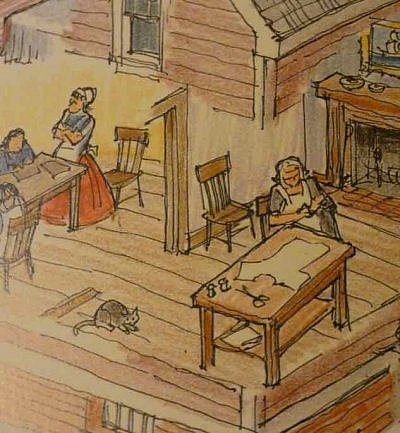Whales. These days you may see them in a distance out to sea, or in a book, or as part of an exhibit in a museum.
Time was that the lives of whales shaped a good part of the lives of people along the Atlantic coast of the United States, and of the coastal lives you see even now, when the whale is respected rather than hunted.
You will learn a lot about all this through a visit to Tuckanucket. You will learn about history, sure, but also about community, co-operation, ecology, nature, art, and creativity.

Tuckanucket is imaginary: it is not a real place. Its stories come vividly to life through the words and art of Mark Foster and Gerald Foster, in their book Whale Port: A History of Tucaknucket.
The Fosters begin their story in 1683, when several families from England come to settle in a cove in southern New England that the First Nations people of the area have named Tuckanucket.
As they made their lives there, they worked with the resources nature provided and traded for things they could not make themselves. The settlers had not expected to find whales, though. When the carcass of one drifted ashore, the Fosters point out, people knew the oil, needed for light, and whalebone, which had many uses, would be valuable for trade, so they harvested these things.
Gerald Foster’s illustrations show how folk lived at this time, in small one room structures not far from the shore, keeping farm animals, trading with First Nations people and others along the shore, and gradually learning learning how to make use of drift whales and– you see where this is going — venturing out in small boats to hunt for the slowest ones. You will learn a bit about what whales were hunted then, and why, as well.

Not quite a century passed when people began seeking whales father out to sea, and building ships with which to do that. In the settlement of Tuckanucket, that meant a cooper, who built barrels to hold the whale oil, and a smith, to make tools needed for the trade, were invited to the town. Did you know that blacksmiths who focused on tools for seafaring where called shipsmiths? Makes sense. Marks Foster’s stories tell of their place in the now whale port of Tuckanucket, and Gerald Foster’s drawings let you see what life was like for these craftspeople and their apprentices. You’ll see what the cooper’s work was like and explore the look fothose tools the shipsmith made, too.

By 1770, Tuckanucket not only sent out ships to seek whales, but sent its own ships to carry whale oil and whale bone for trade across the Atlantic. You can see the the town stretching out from the shore and its docks, with a church, a school, several store houses, and boatyards, as well as farms and roads heading further away.
You’ll also learn about the houses people lived in, many of them in a style called saltbox, and how life worked in those houses, down to the woman stirring batter in a bowl and the cat dozing under her kitchen table.

As time goes on, you will hear and see about the trials the town faced, including ocean born storms and land based fires. You’ll also learn about other trades and how they came to work as the town grew, work including textile making both for ship needs and for clothing, and candle works, useful for the town’s needs and as an offshoot of the whale oil trade.
What about the whales? They were still seen at this time as an inexhaustable resource. The Fosters take you out to sea with the ships and the men who worked on them.
Change was coming though, as whaling shifted westward after the US Civil War, and as lighting began to be powered by petroleum from the ground rather than whale oil.You will get a glimpse of Tuckanucket’s whaling families working to the west and seeking other ways to prosper as well as a look at how whale bone, used in corsets and other clothing, was being replaced. Though you will see how people now lived in triple decker houses in Tuckanucket, you will also find that they were more likely to make their livings from mills and other inland businesses, than from the sea.

Whales were protected from harvesting in 1973, but many face dangers still, from pollution, getting tangled in fishing lines, and the like. In the Fosters’ stories and illustrations, they bring things to a close with a museum of whales and whaling and an office of the Whale Studies Group being established in the town. Good next steps for an imaginary town — or a real one.
Mark Foster is a museum exhibit designer; Gerald Foster is an architect. They are father and son, and have both had lifelong interests in America’s maritime history. There’s history, information, and humour — follow the subtle adventures of cats through the illustrations for one aspect of that– in a book that will be of interest to both adults and children, and a good book to share across generations.
Whale Port also makes a good preparation or remembrance for visiting a real life New England maritime town or museum. If you’d like to do that, several I’d suggest are Mystic Seaport. in Connecticut. The Salem National Maritime site. in Massachusetts, and the New Bedford Whaling Museum , also in Massachusetts.

Consider subscribing to our stories through e mail, and connecting with us through your favorite social networks. You will find links to do that in the sidebar — and while you’re at that social network exploring, we invite you to keep up with our adventures by liking the Perceptive Travel Facebook page.
